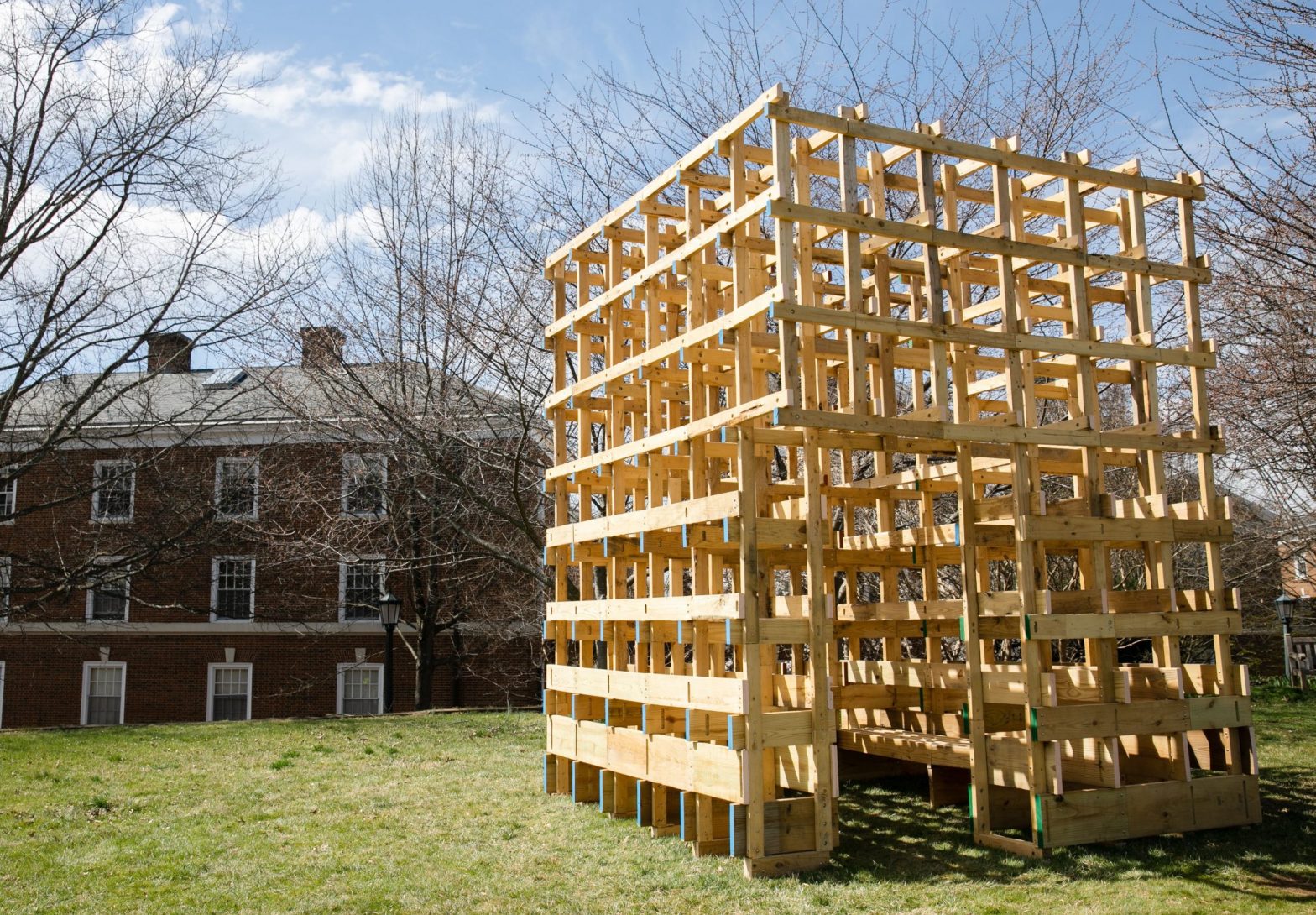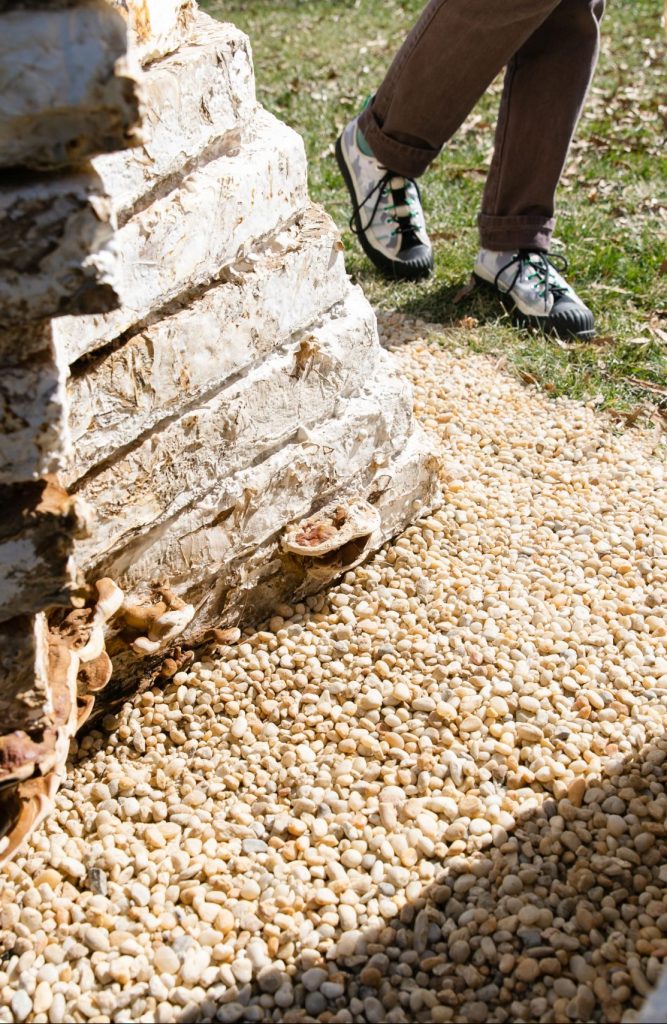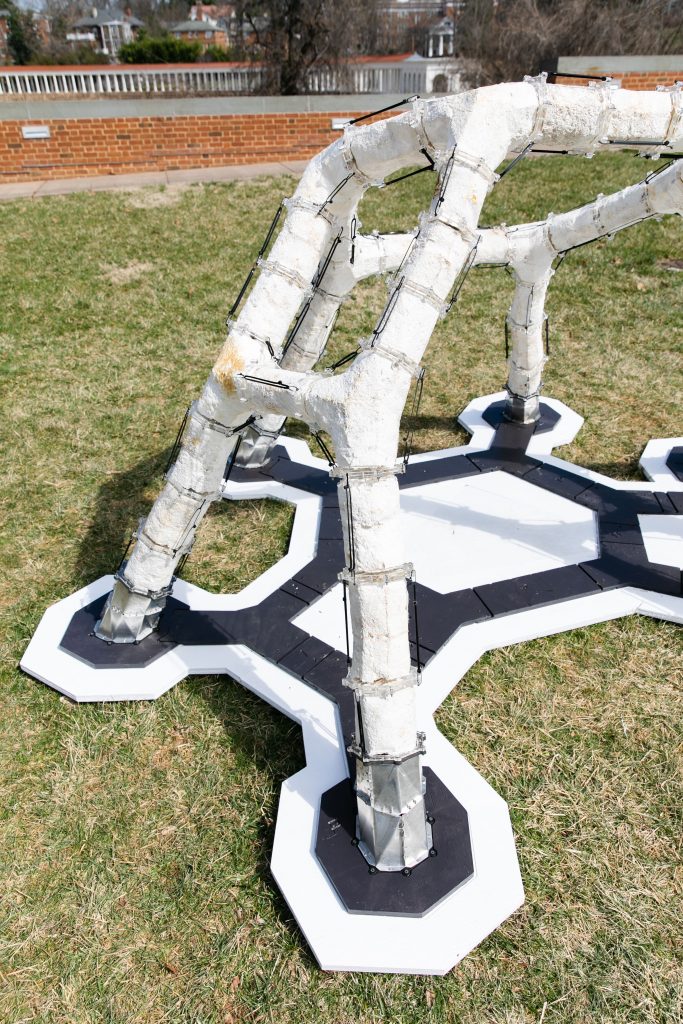By Matt Dhillon
There is a moment when our things stop being our things and begin their new life as trash. It is the frighteningly casual act of throwing something away. Once it is trash, it is forgotten, discarded, and buried, but we know that our wastefulness is catching up with us.
It’s a problem that is being discussed in many disciplines, but UVA’s School of Architecture recently brought the issue to the sidewalks and lawns of Grounds with its Biomaterials Building Exposition. The completion of five installations under the direction of architect-scholars from Penn State University, Cornell University, University of Arkansas, Rice University, and Kansas State University addresses sustainability, decay, permanence, and alternative building strategies in the ways that we inhabit space.
Organized by Katie MacDonald and Kyle Schumann, assistant professors at the UVA School of Architecture, the exposition seeks to display innovations in biomaterials and their potential for construction. The organizers say the construction industry has been slow to recognize its responsibility in climate shifts and even slower to respond.
“In the current building culture, the life span of buildings is rapidly decreasing,” says designer Jonathan Dessi-Olive, from Kansas State University. He pointed to the Georgia Dome in Atlanta, which was built in 1992 and demolished in 2017.
“The building was thrown away much like you would throw away a paper cup. And this is something that’s happening all over the world,” he says.
The EPA reported that in 2018 the United States produced over 600 million tons of debris from construction and demolition activities for buildings, roads, bridges, and other structures. The majority of this waste was relatively permanent material, such as concrete, asphalt, and steel.
The five installations in the BBE offer alternatives that use biological systems in ways that are both practical and conceptual.
“To think about structural materials that aren’t concrete and steel is really the focus of the work,” MacDonald says.
Wood
From fire to log cabin to timber frame to wood frame (which makes up the majority of homes in the U.S. today), wood has been an essential and available form of shelter. But the same EPA report found that almost 41 million tons of wood debris was generated in 2018, with about 70 percent ending up in landfills.
“Mix and Match,” from the University of Arkansas, proposes salvaging that waste. The project recycles the odds and ends of scrap wood by using lap joints to stitch together the lengths desired. Lap joints are always supported from behind by solid wood, and cross pieces reinforce the structure, resulting in a Lego-block-like composition of cubed frames. Also in Lego-block fashion, the project focuses more on assembly than the final structure. The boards can be disassembled and reassembled in new configurations, using the lap joints to fasten the pieces into a different shape.
The millions of tons of wood wasted each year is only a fraction of the wood wasted in logging, selecting the best trees, and milling them into the shapes used for building. “Unlog,” from Cornell University, makes use of the natural curve and forks of trees.
“As a building material, we encounter wood as a 2×4 or plywood or other standardized dimensions, but as we all know wood comes from trees that are non-standard,” says Sasa Zivkovic, one of the designers of “Unlog.”
The installation is made from six logs cut in accordion style zigzags so the logs can be unfolded into a wall. The logs are arranged into a serpentine A-frame that challenges the boxy geometries traditionally imposed on wood.
Decay
Our concern is typically for how to preserve a structure and not how it will decompose, even though decay is inevitable. Rice University’s “From Wood to Tree” explores incorporating decomposition into the design. Contrasting the gravity and grandeur of monuments, the installation plucks at the temporary nature of our time here.
Made with four frames of different kinds of wood, the structure is intentionally gouged to expose the interior to the environment and encourage fungal growth. The frames are penetrated by nearby trees undermining the wall in its classical embodiment of separation between ourselves and the environment, inside and outside, human and non-human spaces.
Mycelium
It is in decay that some architects have found a novel, organic building material. A growing wave of builders are using the roots of mushrooms to grow bricks on agricultural waste. The mycelium can be grown into any shape as long as one has the form to mold the substrate. The pieces are then glued together through myco-welding, which occurs as the mycelium of one piece grows into the mycelium of another.
“MycoCreate,” from Penn State, works with the compressive strength of mycelium to build an arched, hut-shaped structure relying only on the compressive strength of its several columns. The structure’s weblike shape invites asymmetry, which opposes the ordered shapes of traditional buildings and gives an organic feel to the installation.
Kansas State’s “La Parete Fungina” investigates further the process of myco-welding. Currently, most mycelium structures are grown in parts and fired to stop the fungal growth. Designer Dessi-Olive sees this as a limitation because the parts can only be as big as is manageable in the oven, which compromises the strength of the myco-weld.
This installation, made of myco-welded bricks, reflects and distorts the form of the serpentine walls found on Grounds, positioning mycelium as a masonry alternative to concrete. And this wall is alive. The spongy, mottled-gray bricks have an aged stone appearance, but the living, reishi heart is apparent when you see the mushroom caps sprouting on the base.
However, living in a mushroom house is still a long way off. The material is lightweight and has strong insulative and acoustic properties, but its load-bearing capacity is pretty low. Though, as the architects remind us, a building is a system composed of many different materials working together.
MacDonald and Schumann are impressed with the potential they see. “It’s important to remember that these are proof of concept of primarily one material system in each of these installations. In reality buildings are much more complex than that,” Schumann says.








